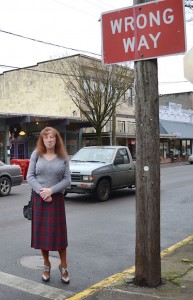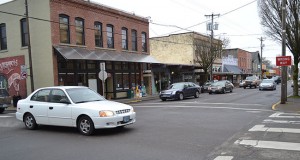
By Don Murtha
After 40 years, it’s time to change Silverton’s one-way traffic system back to the two-way streets. Or so says Silverton Mayor Stu Rasmussen
The Oregon Department of Transportation (ODOT) is discussing his proposal to change traffic flow in downtown Silverton.
As rationale for changing the streets back to two-way, Rasmussen cites improved business vitality, pedestrian safety, visitor friendliness, less confusion and better flow.
“Statistics show that when cities change from one-way streets to two-ways there is almost never a down side and almost always vast improvements,” he said.
“The people in Vancouver, Wash. were absolutely amazed at the change. It slowed traffic, improved business and made the streets safe for pedestrians,” Rasmussen said.
He notes that the cities of Buffalo, N.Y., Saint Augustine, Fla. and others experienced the benefits when they did away with one-way streets.
In Silverton, the one-way streets extend from C to Lewis streets on Water going south and First heading north.
Jason Gottgetreu, Silverton’s community development director, met on Feb. 12 with ODOT to discuss two-way streets for Silverton.
“ODOT is easy to work with and they are open to the idea (of two-way streets),” Gottgetreu said.
Among the benefits to having two-way streets, Gottgetreu said, would be slower traffic flow, better understanding of traffic by visitors, greater pedestrian safety and better accommodation of heavy truck traffic through the city.
The fate of the proposal will depend on an extensive traffic study to be done by ODOT. The study would involve considerations such as truck movement, delivery services, changes of signs and traffic lights, and traffic flow as much as 20 years into the future.
“The study would also consider traffic in town and outside of town. A lot of traffic passes through Silverton,” Gottgetreu said.
The proposal is only in the discussion stage now. To advance, the city would be responsible to pay for the study.
Gottgetreu said the final decision on whether to change traffic from one way to two way streets would be up to the people and the Silverton City Council.

Silverton established the one-way system in 1974 when ODOT built the bridge over Silver Creek on Main Street.
“At that time the mission of the state was for cars to move as fast as they could through town,” Rasmussen said. “Pedestrians were an annoyance.”
“It was stupid then and it’s not smarter now,” he said.
“At intersections drivers look only in one direction to see if cars are coming. They don’t pay attention to whether pedestrians are crossing.”
Rasmussen said people accepted the one-way streets and then a lot of people forgot about it.
“It’s been my mission for 40 years to reverse the system,” he said.
“Admittedly, I have a vested interest. I know it would be better for my business at the theater,” Rasmussen said.
“Before the one-way streets Silverton was an active, vibrant, busy downtown,” he said. “When the one-way streets came in it changed.”
He estimated that the cost to make the change at about $50,000 to $60,000 plus the cost of doing the traffic study.
“In terms of individuals that’s a lot of money, but for a government it’s a drop in the bucket,” Rasmussen said.
There may be grant money available to ease the cost to the city, he added. Another benefit to the city could be the installation of bike racks in downtown Silverton.
“Cars can’t park within 20 feet of an intersection and that space could be used for bike racks,” Rasmussen suggested.
So far there has been no opposition to the two-way proposal.
“There will be opposition. Everyone is afraid of change,” Rasmussen said.
“There will be opposition based on emotion and opposition based on the facts. The facts are incontrovertible and will stand up to opposition,” he said.
“When it is done and they see the benefits, they’ll ask themselves, ‘Why did we wait so long,’” Rasmussen predicted.
When does he expect to accomplish his goal?
“Some time before I die,” he said.